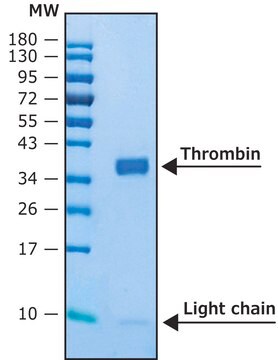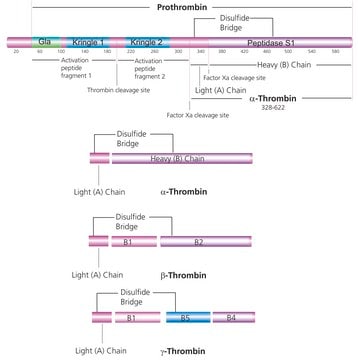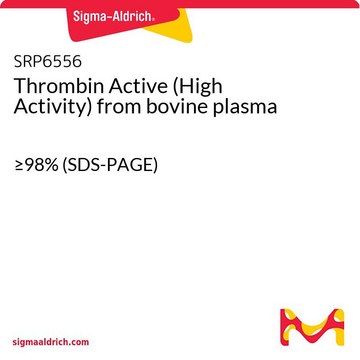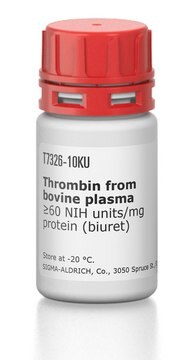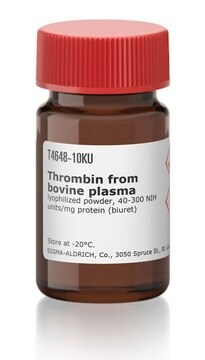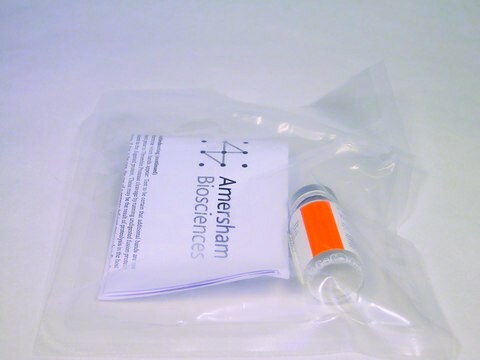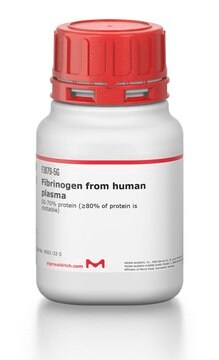SRP6557
Thrombin Active from human plasma
≥95% (SDS-PAGE), recombinant, lyophilized
Sinónimos:
Activated Factor IIa
Iniciar sesiónpara Ver la Fijación de precios por contrato y de la organización
About This Item
Código UNSPSC:
12352202
NACRES:
NA.32
Productos recomendados
Nombre del producto
Thrombin Active from human plasma, ≥95% (SDS-PAGE)
origen biológico
human
Ensayo
≥95% (SDS-PAGE)
Formulario
lyophilized
potencia
>3000 units/mg
mol peso
37 kDa
envase
pkg of 1000 units
pkg of 250 units
Nº de acceso UniProt
Condiciones de envío
wet ice
temp. de almacenamiento
−20°C
Información sobre el gen
human ... F2(2147)
Descripción general
Thrombin enzyme (activated factor IIa) is an important clotting promoter that controls the transformation of soluble fibrinogen to insoluble active fibrin strands. Thrombin is a coagulation protein and a serine protease (EC 3.4.21.5) that catalyzes many coagulation-related reactions. It is primarily associated with blood clotting.
Acciones bioquímicas o fisiológicas
Thrombin triggers factor-XI, factor-V, Factor-XIII and factor-VIII. Thrombin endorses platelet activation, using activation of protease-activated receptors on the platelet. It also induces inflammation. As a result of its high proteolytic specificity, thrombin has become an important biochemical protein. The thrombin cleavage site (Leu-Val-Pro-Arg-Gly-Ser) is widely used in linker regions of recombinant fusion protein constructs. After the purification of the fusion protein, thrombin is used to cleave between the Arginine and Glycine residues of the cleavage site, efficiently removing the purification tag from the protein of interest with a high degree of specificity.
Forma física
Lyophilized from a buffer composed of 20 mM Bis-Tris, 150 mM NaCl and 0.1% PEG 8000, pH 6.5.
Reconstitución
A working stock solution can be prepared by adding 1 mL buffered saline, pH 7.4 (ex. 25 mM HEPES, 150 mM NaCl, 0.1% PEG 8000, pH 7.4). Further dilution should be made in buffer containing a suitable stabilizing agent such as 0.1%-1% Prionex, BSA, or PEG.
Cláusula de descargo de responsabilidad
RESEARCH USE ONLY. This product is regulated in France when intended to be used for scientific purposes, including for import and export activities (Article L 1211-1 paragraph 2 of the Public Health Code). The purchaser (i.e. enduser) is required to obtain an import authorization from the France Ministry of Research referred in the Article L1245-5-1 II. of Public Health Code. By ordering this product, you are confirming that you have obtained the proper import authorization.
Palabra de señalización
Danger
Frases de peligro
Consejos de prudencia
Clasificaciones de peligro
Eye Irrit. 2 - Resp. Sens. 1
Código de clase de almacenamiento
11 - Combustible Solids
Clase de riesgo para el agua (WGK)
WGK 3
Elija entre una de las versiones más recientes:
Certificados de análisis (COA)
Lot/Batch Number
¿No ve la versión correcta?
Si necesita una versión concreta, puede buscar un certificado específico por el número de lote.
¿Ya tiene este producto?
Encuentre la documentación para los productos que ha comprado recientemente en la Biblioteca de documentos.
Los clientes también vieron
Exogenous thrombin delivery promotes collateral capillary arterialization and tissue reperfusion in the murine spinotrapezius muscle ischemia model.
Bruce AC and Peirce SM
Microcirculation (New York, N.Y. : 1994), 19(2), 143-154 (2012)
Tobias Strittmatter et al.
Nature chemical biology, 18(10), 1125-1134 (2022-08-09)
Cellular therapies remain constrained by the limited availability of sensors for disease markers. Here we present an integrated target-to-receptor pipeline for constructing a customizable advanced modular bispecific extracellular receptor (AMBER) that combines our generalized extracellular molecule sensor (GEMS) system with
Structure of the thrombin complex with triabin, a lipocalin-like exosite-binding inhibitor derived from a triatomine bug.
Fuentes-Prior P
Proceedings of the National Academy of Sciences of the USA, 94(22), 11845-11850 (1997)
Hadar Peeri et al.
Cancers, 13(7) (2021-05-01)
Glioblastoma multiforme (GBM) is the most lethal subtype of glioma. Cannabis sativa is used for the treatment of various medical conditions. Around 150 phytocannabinoids have been identified in C. sativa, among them Δ-9-tetrahydrocannabinol (THC) and cannabidiol (CBD) that trigger GBM
Nuestro equipo de científicos tiene experiencia en todas las áreas de investigación: Ciencias de la vida, Ciencia de los materiales, Síntesis química, Cromatografía, Analítica y muchas otras.
Póngase en contacto con el Servicio técnico